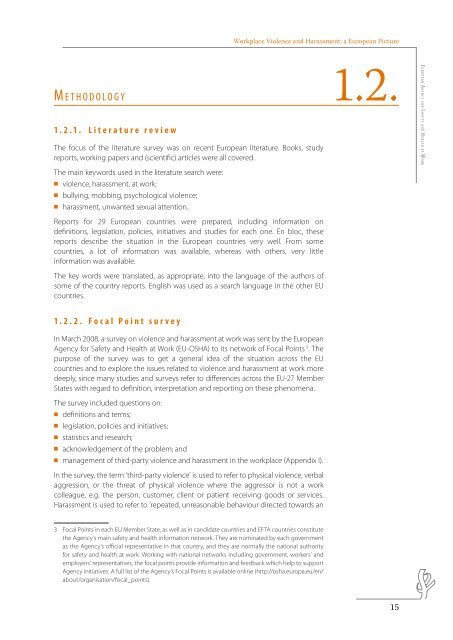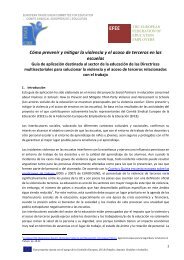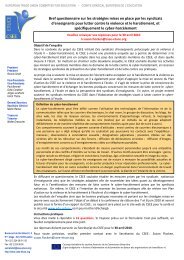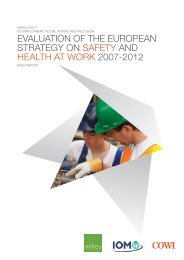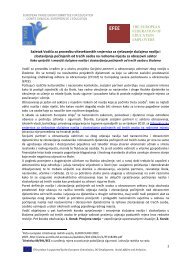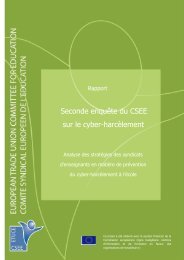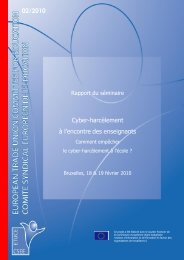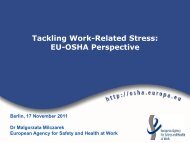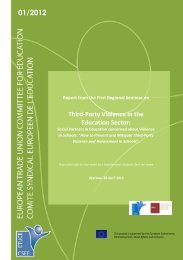Workplace Violence and Harassment: a European Picture
Workplace Violence and Harassment: a European Picture
Workplace Violence and Harassment: a European Picture
Create successful ePaper yourself
Turn your PDF publications into a flip-book with our unique Google optimized e-Paper software.
<strong>Workplace</strong> <strong>Violence</strong> <strong>and</strong> <strong>Harassment</strong>: a <strong>European</strong> <strong>Picture</strong>M e t h o d o l o g y 1.2.1.2.1. Literature reviewThe focus of the literature survey was on recent <strong>European</strong> literature. Books, studyreports, working papers <strong>and</strong> (scientific) articles were all covered.The main keywords used in the literature search were:OO violence, harassment, at work;OO bullying, mobbing, psychological violence;OO harassment, unwanted sexual attention.Reports for 29 <strong>European</strong> countries were prepared, including information ondefinitions, legislation, policies, initiatives <strong>and</strong> studies for each one. En bloc, thesereports describe the situation in the <strong>European</strong> countries very well. From somecountries, a lot of information was available, whereas with others, very littleinformation was available.The key words were translated, as appropriate, into the language of the authors ofsome of the country reports. English was used as a search language in the other EUcountries.E u r o p e a n Ag e n c y f o r Sa f e t y a n d He a l t h a t Wo r k1.2.2. Focal Point surveyIn March 2008, a survey on violence <strong>and</strong> harassment at work was sent by the <strong>European</strong>Agency for Safety <strong>and</strong> Health at Work (EU-OSHA) to its network of Focal Points 3 . Thepurpose of the survey was to get a general idea of the situation across the EUcountries <strong>and</strong> to explore the issues related to violence <strong>and</strong> harassment at work moredeeply, since many studies <strong>and</strong> surveys refer to differences across the EU-27 MemberStates with regard to definition, interpretation <strong>and</strong> reporting on these phenomena.The survey included questions on:OO definitions <strong>and</strong> terms;OO legislation, policies <strong>and</strong> initiatives;OO statistics <strong>and</strong> research;OO acknowledgement of the problem; <strong>and</strong>OO management of third-party violence <strong>and</strong> harassment in the workplace (Appendix I).In the survey, the term ‘third-party violence’ is used to refer to physical violence, verbalaggression, or the threat of physical violence where the aggressor is not a workcolleague, e.g. the person, customer, client or patient receiving goods or services.<strong>Harassment</strong> is used to refer to ‘repeated, unreasonable behaviour directed towards an3 Focal Points in each EU Member State, as well as in c<strong>and</strong>idate countries <strong>and</strong> EFTA countries constitutethe Agency’s main safety <strong>and</strong> health information network. They are nominated by each governmentas the Agency’s official representative in that country, <strong>and</strong> they are normally the national authorityfor safety <strong>and</strong> health at work. Working with national networks including government, workers’ <strong>and</strong>employers’ representatives, the focal points provide information <strong>and</strong> feedback which help to supportAgency initiatives. A full list of the Agency’s Focal Points is available online (http://osha.europa.eu/en/about/organisation/focal_points).15


